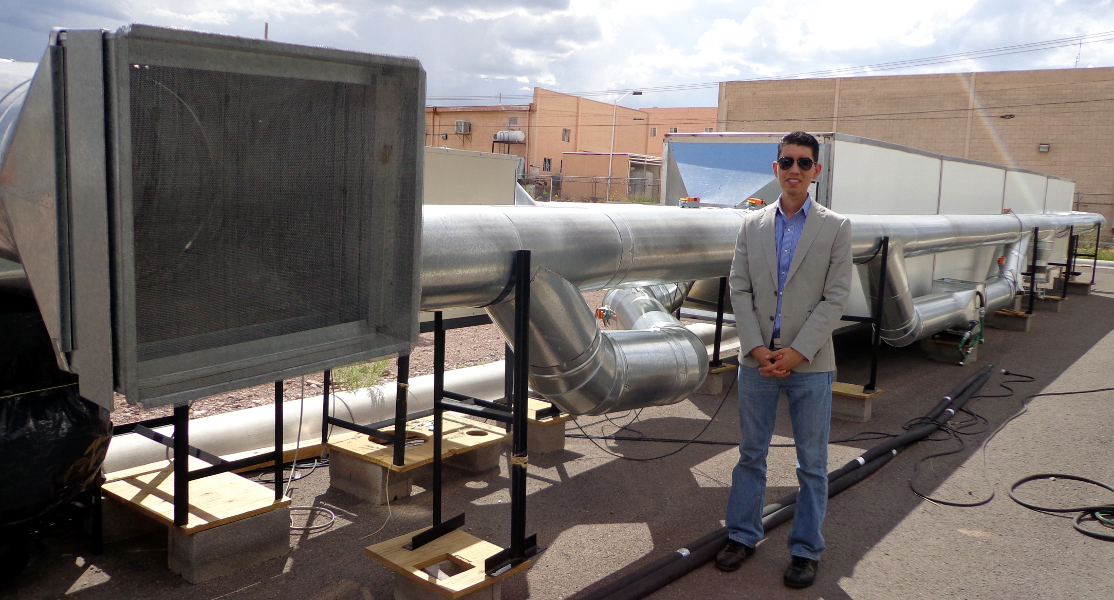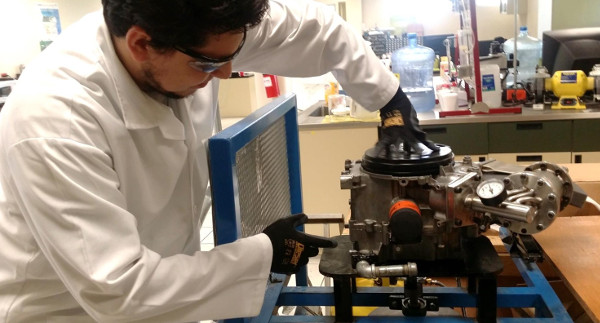Solar thermal cogeneration research

Ricardo Beltrán on ResearchGate
https://www.researchgate.net/profile/Ricardo_Beltran
ORCID ID
https://orcid.org/0000-0002-2253-0673
Specialists on this subject aim to improve, design and to develop technologies in order to reduce consumption of fossil fuels by harnessing the use of renewable energy, particularly solar, as well as the application of techniques for efficient use of energy.
The topics developed by this group of specialists includes: generation of electricity from different heat sources, the use of thermal energy for food processing and the activation of indoor climate systems, whether for heating or cooling both from the heat produced by solar energy.
Among the applications for food processing, Cimav researchers designed and built a dryer for the commercial production of chipotle chili for exportation. This process reduce the use of firewood consumption to a 95% than conventional oven.
The dryer allows a significant reduction of environmental impact by replacing fossil fuels with solar energy. This technology was developed and transferred to the productive sector through an idustrial size prototype which has a capacity of 4.3 tons of chipotle chili.

Cimav researchers are working on projects to generate electrical power through the design, construction and test of Stirilng engines as well as Organic Rankine Cycle (ORC), which operates using solar collectors at temperatures of 800 °C and 80 °C respectively. At the moment, the selected target area is the domestic sector, considering a supply power capacity of 1000 W (1.3 hp), however its use and application in other sectors is easily adaptable due to the simplicity of its installation method and operation.
In addition, specialists from the Environment and Energy Department are developing a technology to meet the needs of a controlled climate inside greenhouses. This desiccant evaporative cooling system is activated by the heat produced by solar energy.
This project seeks to reduce the operating cost for air conditioning and to increase crop yields by keeping them in optimal conditions of temperature, humidity and carbon dioxide (CO2).
The benefits of research projects besides academic contributions, include select, improve and reduce costs of emerging technologies to provide alternative solutions to energy problems IN the productive sector. This is intended to make research products to be assimilated and implemented more easily in areas which the integration of renewable energy is cost-effective. As a result of each project, the training of human resources in undergraduate and postgraduate degree increase in a state of the art thermal technology topics, generally is directed for specific users, whether entrepreneurs or producers.
Solar thermal cogeneration research:
- To develop technologies to harness renewable resources to meet energy requirements, in consideration of the available technical capabilities and economic opportunities in the country.
- Human resource development and training able to select, assimilate and improve latest technologies; adapting them to the needs of the region and/or user.
- Promote energy sustainability through design, manufacture, operation and maintenance of technological packages, products and services that provide the opportunity to generate jobs and economic activities based on the application of state of the art technology.
The technologies for harnessing solar energy, include photovoltaic panels, which can transform directly sunlight into electrical energy. Even when in some cases the marketing of panels and photovoltaic systems is a profitable and cost-effective alternative; the research into applications of solar thermal energy, aims to harness the heat produced by solar energy; in order to take advantage of the technical and human infrastructure developed by the metalworking, construction, aeronautics and electronics sectors. This allows the development of technological packages for production of cold, heat or electric energy to be transferred more quickly and assimilated by the productive sectors, to create well-paying jobs.
Working in collaboration with companies and institutions it has been requested the protection of industrial property through four patents: two for the engine and two for the oven.
The first patent was registered in collaboration with the Autonomous University of Baja California, is about a solar Stirling engine, and the second patent is about the control device that allows the production of electrical power in compliance with grid requirements.
The patent related to the chili dryer, protects the design and operation for the production of chipotle chili with industrial capacity. While the fourth patent application protects the ventilation system wich reduces production time and uses solar energy in order to reduce fuel consumption.
Environmental benefits
The projects generated BY this research seek to offer alternative and cost-effective solutions for energy supply and sustainable use of wáter resources, to improve competitiveness and reduce fossil fuel consumption, emissions of greenhouse gases and degradation of groundwater.
- Magnetic refrigeration.
- Solar Thermal Micro Organic Rankine Cycle
- Freeze drying with heat integration.
- Point focus solar concentrator.
- High temperature thermal energy storage.
- Integrated solar thermal roofing systems.
- High temperature Stirling engines.
- Renewable energy oriented GIS technology as planning and decisión-making tool.
